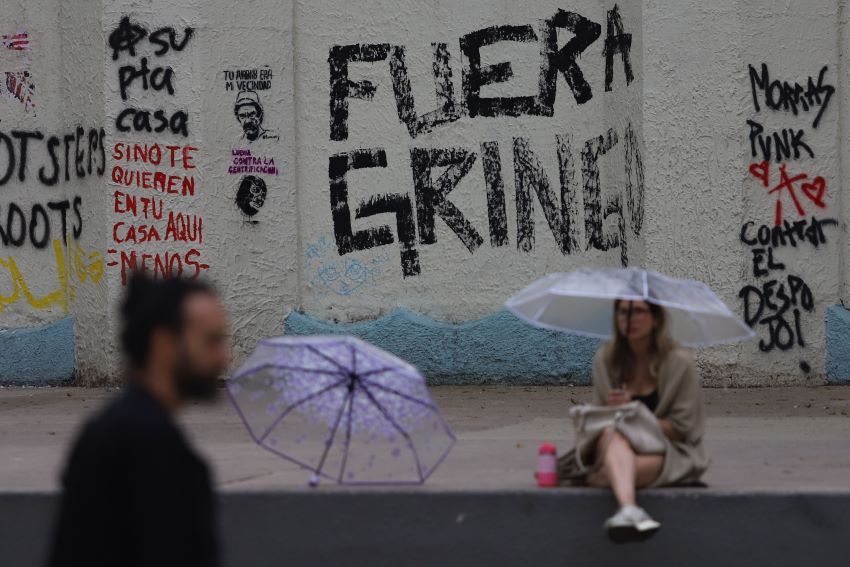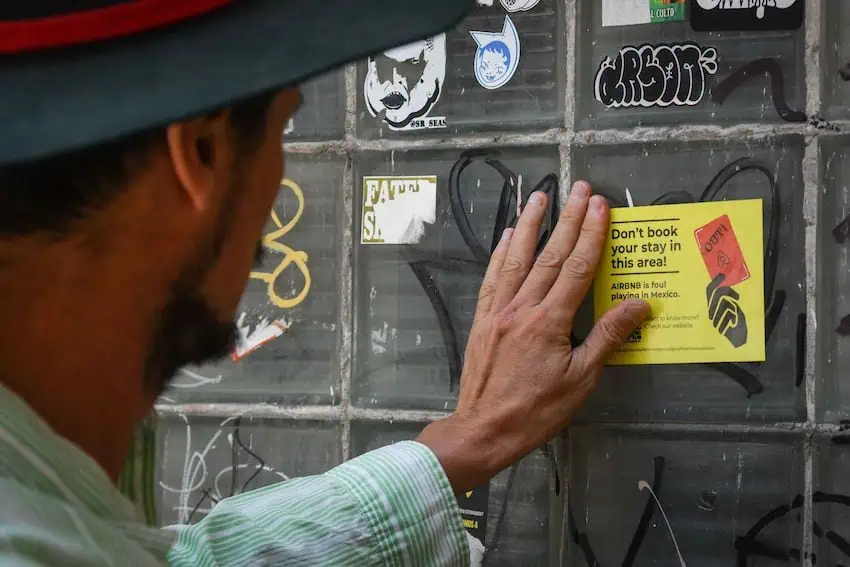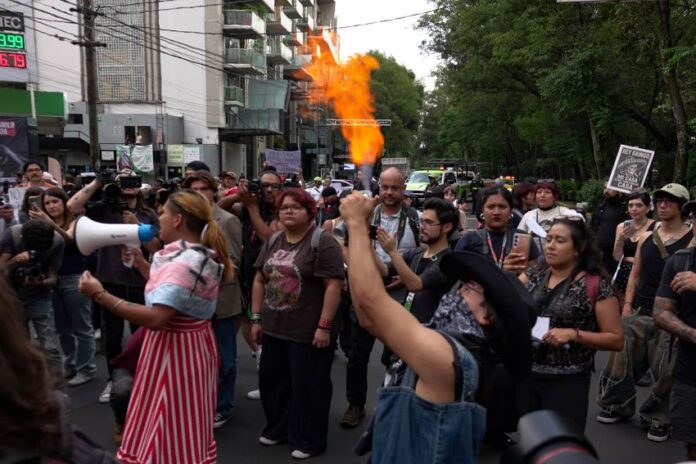Hundreds of people protested in Mexico City on Friday against the gentrification of neighborhoods where many foreign residents live and many foreign tourists stay, such as Condesa and Roma.
The protesters gathered on Friday afternoon in the Lindbergh Forum section of Condesa’s Parque México, where they held up placards with messages such as “Free us from American gentrification”; “You’re visiting paradise, we’re being pushed out”; “You’re not an expat, you’re an invader”; “Foreigners love Mexico, but hate Mexicans;” and “Dispossession comes disguised as Airbnb.”
“Housing to live in, not to invest in!” read a large banner affixed to the imposing five-pillared structure in Lindbergh Forum, a popular gathering and recreation place for both Mexicans and foreigners.
“We’re sick of foreigners coming with their euros and their dollars, wanting to buy our homeland,” said one rally speaker.
“… At the end of the day, if we begin to allow these kinds of things, there won’t be anything or anyone to stop them,” he said.
The protest was organized under the slogan “Gentrification is not progress, it’s dispossession.”
It was promoted on social media by various organizations, including one called Frente por el Arraigo y la Inclusión Vecinal (Front for Neighborhood Roots and Inclusion).
Most of the protesters were young people, among whom were residents, and former residents, of inner-city Mexico City neighborhoods such as Condesa, Roma and Juárez. However, the majority of the protesters live in other parts of the city, according to media reports.
“¡Gringos, go home!”: En la colonia Condesa se realizó la primera manifestación en contra del aumento de rentas y el desplazamiento de vecinos a causa de la gentrificación.
Durante la protesta quemaron una piñata que representa a los extranjeros gentrificadores.
Videos:… pic.twitter.com/utIn86tQFx
— Emeequis (@emeequis) July 5, 2025
The number of foreigners living in neighborhoods such as Condesa and Roma increased significantly during the COVID-19 pandemic. Many of the residents are from the United States, and include people who work remotely for companies in the U.S. and thus earn salaries in dollars.
The influx of foreign residents, and foreign tourists, has changed the face of neighborhoods such as Condesa and Roma and contributed to an increase in rents, forcing some Mexicans out and preventing others from moving into highly desirable parts of the capital. Inflation and other factors have also contributed to an overall higher cost of living in Mexico City and other parts of the country.
The resentment some Mexicans harbor toward well-off foreign residents of the capital is not solely based on rising prices and gentrification, but also stems from perceptions that some of the outsiders make little effort to assimilate and learn Spanish, and don’t significantly contribute to local tax collection.
“You walk around here in Condesa and every two steps you see a foreigner,” one protester told the news magazine Proceso.
“… [They are] people who don’t speak our language, don’t share our culture and are displacing [Mexicans],” he said.
Similar protests against gentrification and mass tourism have taken place in various cities around the world, including Barcelona and Paris.
‘Gringos go home!’
Chants of “¡fuera gringos!” (gringos out!) and “gringos, go home” rang out in Parque México during the demonstration and as protesters subsequently marched through nearby streets of the capital.

While foreigners from many countries around the world live in Condesa, Roma and other central neighborhoods of Mexico City, much of the protesters’ anger was focused on newcomers from the United States.
“Gringo, go back to your fucking country!” and “pinches gringos culeros” (fucking gringo assholes) were among the messages protesters conveyed on signs they held up.
Adding to protesters’ particular anger toward Americans is the unfair treatment many Mexicans believe their compatriots are receiving in the United States as the Trump administration pursues its mass deportation agenda.
In Condesa, some protesters told media outlets that their neighbors have been forced out of parts of Mexico City that are popular with foreigners because many residential properties have been turned into businesses or short-term accommodation advertised online on platforms such as Airbnb.
“We’re being left without neighbors,” one protester told the newspaper Milenio. “A lot of places are now businesses. The rents are going up.”
“We don’t have neighbors anymore,” 82-year-old Condesa resident Raquel Nava told Proceso at the protest in Parque México.
“I’m here because I’m worried that the social fabric of the neighborhood has been lost,” she said.
“… [My] neighbors lived in rentals but with the arrival of Airbnb they couldn’t pay the costs and they were evicted,” Nava said.
She described gentrification as the eviction of residents with ties to the local area and the arrival of “people who don’t integrate into the community.”
“… It’s not that I’m against foreigners, the doors were opened to them and they’re here, but they don’t appreciate the cultural heritage of these neighborhoods,” Nava said.

Michelle Castro, a 19-year-old university student, told the Associated Press that Mexico City “is going through a transformation.”
“There are a lot of foreigners, namely Americans, coming to live here. Many say it’s xenophobia, but it’s not. It’s just that so many foreigners come here, rents are skyrocketing because of Airbnb. Rents are so high that some people can’t even pay anymore,” she said.
Mexicans forced out of desirable central neighborhoods of the capital often face longer, more expensive commutes due to their relocation to cheaper, more peripheral areas of Mexico City.
While businesses such as cafes have proliferated in trendy neighborhoods that are popular with foreigners, the number of traditional businesses such as tortilla and butcher’s shops have declined in recent years, according to official government data.
“A lot of the flavor of the neighborhood is lost,” Erick Ramírez, a long-time resident of Condesa, told Proceso.
“… Stationery stores, dry cleaners and corner stores disappear,” and “more profitable businesses” appear in their place, he said.
While some of the new businesses are owned by foreigners, the proprietors of many of them are Mexicans, who have no doubt benefited from the influx of Americans, Europeans and others with ample disposable income. Airbnb entrepreneurs have also reaped major monetary rewards from the arrival of large numbers of foreigners.
Karla Mejía, a Condesa resident, spoke about economic inequality between foreigners and Mexicans.
“We, as residents, as taxpayers of the Mexican state, can’t afford housing, much less in an area like Condesa, but these people can,” she told Milenio.
Condesa is a leafy, pretty neighborhood and entertainment hub that many people consider ground zero for gentrification in Mexico City. Its array of entertainment options, including cafes, restaurants and bars, its inviting parks and its central location are among the reasons why it attracts large numbers of foreign residents and tourists.
The protest turns violent
While most protestors demonstrated peacefully, a small group committed acts of vandalism and violence in Parque México and nearby streets.
The large structure in Lindbergh Forum was defaced with graffiti messages, including “Housing is a right, not a commodity” and “My culture is not your trend” as well as pro-Palestine statements.
🔴 Durante Protesta Antigentrificación, destruyen Starbucks ubicado en esquina Sonora con Ámsterdam, colonia Hipódromo
📹 Liliana Gómez pic.twitter.com/xMkVVnO0iw
— El Universal (@El_Universal_Mx) July 5, 2025
In the streets of Condesa and Roma, radical, masked protesters smashed the windows of businesses and carried out other acts of violence and vandalism. Among the businesses targeted was a Starbucks cafe, where frightened customers threw themselves to the floor, a branch of the Banamex bank and a clothing store, which protesters looted.
All told, 14 businesses were damaged and 40 more were vandalized with graffiti, according to authorities in Cuauhtémoc, the borough where Condesa and Roma are located.
At Café Toscano, located opposite Plaza Rio de Janeiro in Roma Norte, one employee was injured when protesters attacked the establishment.
“Suddenly, they started throwing tables and chairs. Others came in and threw firecrackers. I took cover to avoid being hit by a rock they threw from outside and I hurt my hand,” Karen Jaramillo told the newspaper Reforma.
“They were moments of a lot of fear,” the cafe employee said.
Cafe manager Fernando Jasso said the business doesn’t contribute to gentrification in the area.
“We’re Mexican workers, the owners are Mexicans, the prices are accessible for everyone,” she said.
In addition to perpetrating acts of violence and vandalism, some protesters hurled insults at foreigners they encountered, according to media reports. Some Mexico City police officers were attacked with stones, the Milenio newspaper reported.
The march through the streets of Mexico City reached the Angel of Independence monument on Paseo de la Reforma, the capital’s most famous boulevard. The base of El Ángel, as the monument is commonly known, was also targeted by vandals.
Protesters also demonstrated outside the United States Embassy on Paseo de la Reforma and chanted inside the Mexico City metro system, according to the Associated Press.
Mayor Brugada and CDMX government denounce violence — and gentrification
The Mexico City government issued a statement after Friday’s protest that Mayor Clara Brugada shared to her social media accounts.
“Mexico City doesn’t agree with gentrification. We reject this phenomenon that excludes the population from their neighborhoods and communities,” the government said.

“For that reason, we promote public housing policies that strengthen [community] roots, with accessible loans for the improvement and construction of housing in these areas. We also implement actions so that young people have access to affordable rental housing and families can obtain home ownership at affordable prices,” it said.
The Mexico City government said it is committed to upholding “the right to decent housing” and asserted that it is implementing “concrete policies” to guarantee it.
“We know that gentrification can exclude those who have lived their whole lives in their neighborhoods. That’s why we’re allocating unprecedented resources to create the conditions that allow them to continue developing their life project in their own community,” it said.
“But in no way do we endorse violence in confronting this problem,” the government added.
“We reject violence as a method to resolve conflicts. This city is one of rights and freedoms. We respect protests and social expressions … but not aggression,” it said.
“… The fight against gentrification cannot become an excuse to promote hate speech or discriminatory practices. We categorically reject any xenophobic expression against migrants, regardless of their origin, migratory situation or motivation for arriving in the city,” the Mexico City government said.
With reports from Animal Político, Milenio, Proceso, La Jornada, Reforma, Excélsior, AP and N+
* Mexico News Daily has previously published numerous articles on gentrification in Mexico City and associated issues. Here is a selection of those articles.
- Foreign invasion brings changes to Mexico City boroughs
- Citizens protest gentrification and housing inequality in Mexico City
- CDMX partners with Airbnb, UNESCO, to promote the capital as a hub for remote workers
- Nasty end for family torta business is symbolic of Mexico City affordability crisis
- Expatriates were in CDMX’s neighborhoods long before COVID
